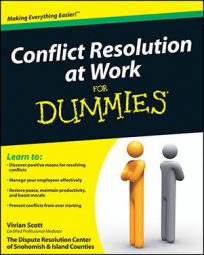It’s common for employees to want to save face and try to resolve a conflict without their manager’s involvement. So, if those involved all feel confident they can handle the situation on their own, let them work it out.
Even though you aren’t guiding them through the conflict resolution process, you can help employees prepare for the conversations that they’ll have with each other. Communicate your expectations for follow-through clearly, and include housekeeping details and decisions such as the following:
Whether their communication will be part of their personnel files
Confidentiality — who needs to know about the meeting and agreements
The timeframe in which you expect them to meet
Your availability for the meeting if needed and how they’ll let you know
What type of feedback you’ll need from their meeting (written or verbal)
How they plan to address future disagreements
How often and in what format you’d like to be informed about progress
The exact date you’ll be checking back in with them
When and where they’ll meet (think safety, comfort, and time of day)
Resources they may need from you, such as access to a private meeting room or someone to cover their shifts
Whether agreements will be in writing or a handshake will do, as well as the level of detail needed in an agreement (such as a summary for you but a detailed document for them)
What they’ll do if they come to a standstill
What homework or preparation is needed prior to the meeting so they have important information on hand
Let both parties know you’re rooting for them, that you have confidence in their ability to look at the situation from each other’s point of view, and that you’re ready to help them as needed.
Coach the parties at various points in the process doing the following:
Ask them to treat each other with common courtesy and to walk away from the conversation without doing additional damage to each other.
Ask them to listen, and assure them that listening doesn’t mean agreeing with what the other person is saying. Listening demonstrates that you respect the other person enough to hear what’s important to her. Ask them not to interrupt one another, and encourage note taking when the urge to say something out of turn arises. Discuss the importance of restating what they heard the other say as a way to demonstrate a willingness to begin to see the other person’s perspective.
Encourage sharing. In one-on-one conversations, you may have heard some key information that, if it were shared, would help create understanding and move the parties forward.

